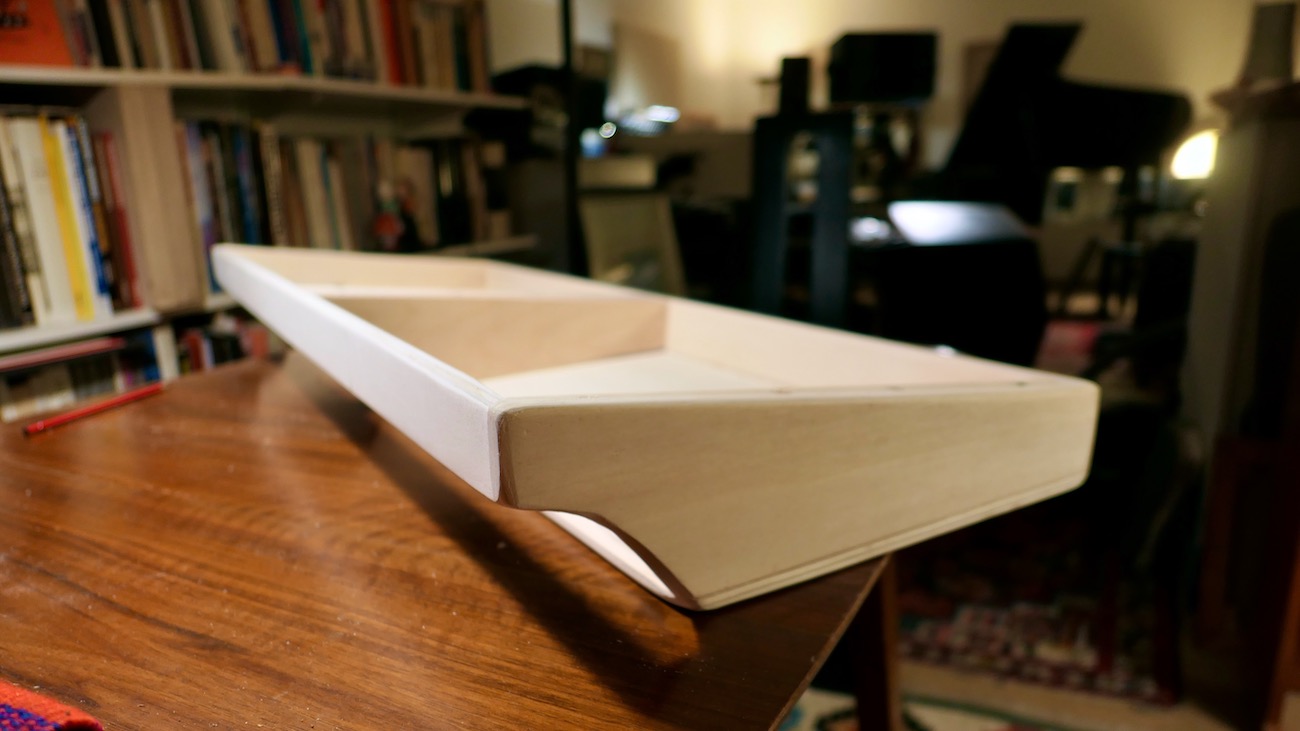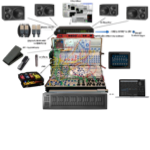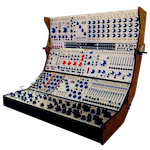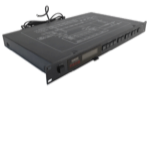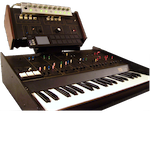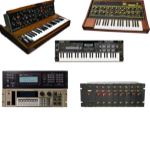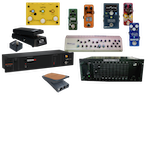Behringer 2600
Gray Meanie

Sure, a single B-2600 is absolutely sufficient, but, after recreating my setup from 1984 (ARP 2600 & FX-pedals) with the Behringer Gray Meanie and being absolutely thrilled with the result, I also materialized my, at that time unfulfilled, wish of using a second 2600. However, I must warn you that there is a great danger of not wanting to play with just one 2600 anymore.
The Gray Meanie appears tonally somewhat tidier, less exuberant than the ARP 2600 originals, sometimes even a bit more nuanced, overall a bit more filigree. The "tidier" transmission also applies to the signals that go via its preamp directly into the VCA. I was very surprised at how similar the ARP Little Brother sounds when I feed it in and compare it to the Behringer VCOs (via the Behringer VCA). The Little Brother has the VCO of the ARP 2600, brings more "vintage 2600 washiness" and is just a bit bolder in the bass register. So, the sonic differences to plugging into the ARP have a lot to do with the VCA - and, especially the VCA was not one of the ARP 2600's strong points! The great sonic similarity of the oscillators of the Behringer 2600 I had not expected, to be honest. Truly impressive!
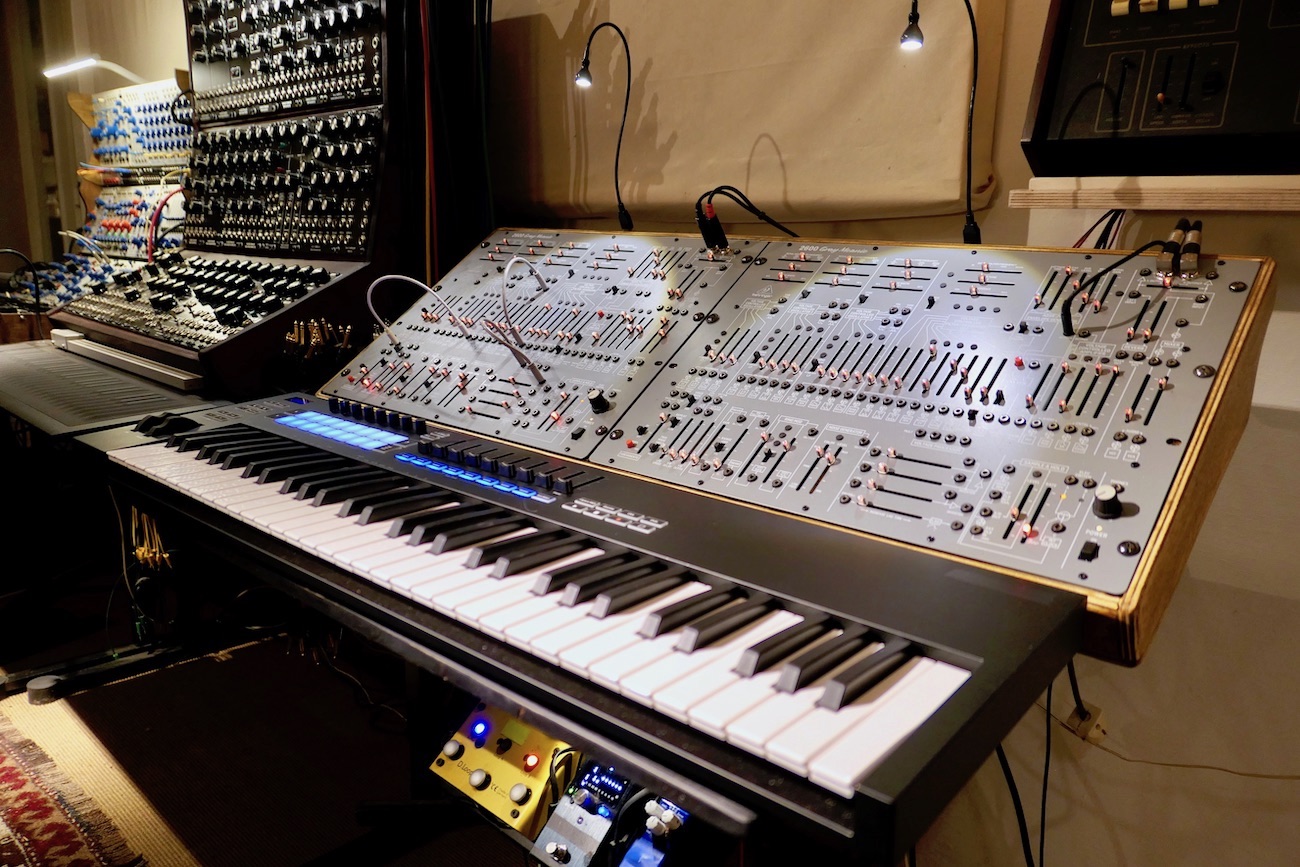
And: fortunately it is different than a 50 year old ARP - it's not as if the ARP 2600 was just perfect. The "Behringer Team" has taken virtually all typical modifications (e.g. time-range for Envelopes and LFO), which were done afterwards on very many ARP 2600, straight into the instrument! Finally the upgrade!
The Behringer 2600 - especially Blue Marvin and Gray Meanie - is THE synthesizer I recommend to anyone who (still) wants to buy a synthesizer, and especially if it is to be the first synth. Gray Meanie, Blue Marvin or simply the Behringer 2600 have the stuff to become the people's synthesizer.
In the second attempt, Behringer has, in my opinion, made the proper changes, because with the black/orange "Behringer 2600" (late 2020) a few things appeared "somewhat unfortunate" to me. Technically this is shown by a "problematic" digital Reverb (with phase cancellation) instead of the Spring Reverb (as in the ARP), and aesthetically problematic for myself was the black/orange design with color-coded LED sliders in the "Christmas tree look". Even with ARP, I felt permanently yelled at by the black/orange design - together with the color-coded sliders, it's definitely an overdose to me. Both have been changed for the models "Blue Marvin" and "Gray Meanie", which have been available since 2021.
The ARP Original
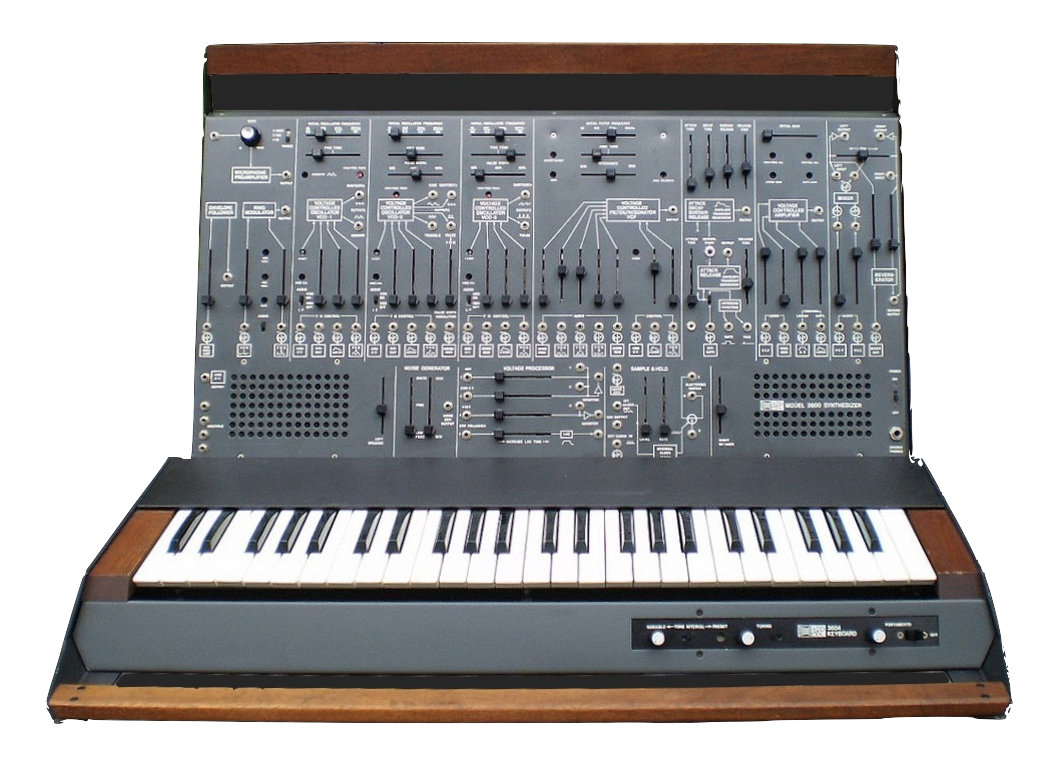
The names "Blue Marvin" and "Gray Meanie" were the pet names of the first two pre-series of the ARP 2600 from 1971 (photo: ARP Gray Meanie). These originals differed from each other only by the color and the better organized production of the Gray Meanie - there were only about 25 of the Blue Marvin and 35 of the Gray Meanie. However, both models contained better components (e.g. Teledyne VCOs), which for reasons of economy have not been used in the later ARP 2600 series.
Details
The two new Behringer models also differ from each other only in color and, unlike the "black/orange" Behringer 2600, they are equipped with "carefully selected, high-quality components for improved performance, a mechanical Spring Reverb and single-color fader LEDs". Hopefully these "high-quality components" will have their impact - it's a generally welcome statement, after all - and hopefully the Teledyne VCOs of the "ARP Gray Meanie" have also received the attention they deserved. Of course, I can't compare all that. However, the monochromatic design and monochromatic LED sliders calm down the look tremendously - and if there's going to be bad Reverb, I'd rather have a Spring Reverb.
Immediately - already with the first B-2600 model - I was impressed by the re-designed panel of the Behringer 2600. Although there are some changes to the original ARP 2600, its character has been perfectly kept intact and this is, especially for former ARP-ists, instantly apparent. The layout clearly shows how carefully "the spirit" of A.R. Pearlman has been carried further here, because the large ARP synths didn't just sound good - they also impressed with their unique panel layouts - even before they had been switched on for the first time! And, thankfully, no useless sequencers or other gimmicks have been added by Behringer to the 2600. The 2600 has been shrunk to 19 inches, 8U, lightened to 5.1 kg, the keyboard, speakers and case have been ditched, and instead the LFO and controllers of the ARP 3620 keyboard have been moved to the 2600 panel - a genuinely good decision, because one of the three VCOs would otherwise have had to do the job of the LFO. This circuitry from the 3620 keyboard is also what makes duophonic operation possible.

The modifications / additions to the Behringer 2600 indicate, as already the re-design of the panel, a great sensibility and plenty of ARP 2600 experience, as exactly those issues have been improved that (at that time) were modified or at least desired by many ARP 2600 owners. Especially the "Time Factor" switches were probably the most common modification of the original ARPs - because the envelopes were neither short nor long enough. However, some things remained unchangeable (for most people) - and Behringer intervened in this regard as well. But first, back to the beginning: in the following picture I tried to point out the differences to the historical original and make them apparent (especially) for non-experts of the ARP 2600. I've adjusted the size ratio of the two models to each other for better identification. The red outlined elements at the Behringer are enhancements of Behringer. ( Note: the first [green] block of the ARP 2600 has slipped into the lower row of the Behringer.)

The (to me) welcomed changes to the historical ARP 2600 start with the weight and size reduction - and this, even in spite of keeping the size of the sliders!!! 5.1 kg of weight can be moved even at an older age - and the omission of the loudspeakers is worth a holiday of its own! The speakers had been on board because it predestined the instrument for schools and universities. 50 years ago it could be quite difficult to find a suitable amplifier/speaker system for a synthesizer in educational environments. Today the situation is reversed: better loudspeakers can probably be found within a few minutes. Especially useful and very important is the "timefactor modification" (often done subsequently on the originals), which enables the envelopes to be made half or twice as long (3-position switches with *0.5,*1.,*2.). Behringer does provide them! Very, very, very good!
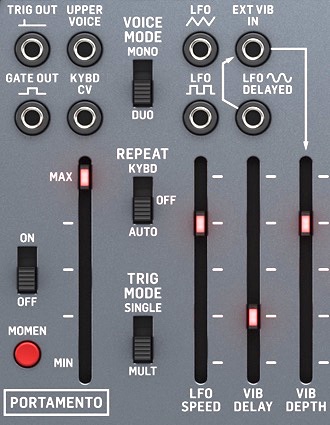 The original VCO1 and VCO3 have been expanded on the Behringer: VCO1 has received a "Pulsewidth" slider, which removes the limitation to Saw and "Square" - and converts it to Saw and "Pulse" (a pulsewidth of 50% produces "Square"). VCO3 has gotten the additional waveforms Tri and Sine and a Pulsewidth modulation as well - thus there also is one more Slider. Now VCO3 is identical to VCO2 - and both (VCO2 and VCO3) have also been given a sync switch. Cool.
The original VCO1 and VCO3 have been expanded on the Behringer: VCO1 has received a "Pulsewidth" slider, which removes the limitation to Saw and "Square" - and converts it to Saw and "Pulse" (a pulsewidth of 50% produces "Square"). VCO3 has gotten the additional waveforms Tri and Sine and a Pulsewidth modulation as well - thus there also is one more Slider. Now VCO3 is identical to VCO2 - and both (VCO2 and VCO3) have also been given a sync switch. Cool.
The 3620 keyboard's Modulators on the 2600 are a true blessing! Due to the LFO they provide modulated three-voice sounds (or two-voice sounds, each with its own LFO) - otherwise one VCO would have to be used as an LFO. An important feature here is the "Voice Mode" switch, which allows switching between monophonic and duophonic operation from the 2600 itself (and no longer solely from the keyboard). This feature was introduced by ARP only with the latest 3620 keyboard. I for instance owned an early ARP 2600 with the 3604 keyboard - and the 3620, which made the 2600 duophonic, remained an open wish for me, since it was virtually impossible to get it separately after the end of the ARP Instruments company in 1981.
These Modulators, "ported" from the 3620 keyboard, create an enormous improvement over the original ARP 2600 and at the same time allow a less specialized keyboard (like a normal MIDI keyboard) to be used, without any loss of functionality compared to the latest ARP 2600 version.
MIDI, CV and Connectors
 The MIDI implementation has been kept as simple as possible. The Behringer 2600 understands NoteOn / -Off and Pitchbend. That's it. However, fortunately there is a software (app) with which the two extremely important parameters "PitchBend Range" (max. 12 semitones) and "Key Priotity" (Low/High/Last) can be altered. This is quite manageable. Of course, the app would be desirable as an app for mobile devices as well, i.e. on iOS and Android.
The MIDI implementation has been kept as simple as possible. The Behringer 2600 understands NoteOn / -Off and Pitchbend. That's it. However, fortunately there is a software (app) with which the two extremely important parameters "PitchBend Range" (max. 12 semitones) and "Key Priotity" (Low/High/Last) can be altered. This is quite manageable. Of course, the app would be desirable as an app for mobile devices as well, i.e. on iOS and Android.
The second tab of the software is also interesting: here the calibration for the second voice (upper voice) seems to be done. I will have a closer look at it when I get an opportunity. First I did some MIDI performance tests: there have been no note hangups and also no other issues, everything worked fine. The pitch bend operates in a clean manner - and the 14 bit resolution makes it great for microtuning! Also the ARP Little Brother connected to the "KYBD CV" was tracked exactly identical - also with inverted CV.
I was impressed that the Gray Meanie delivers 14V Trigger and a 10V Gate. ARP triggers were 15V and were accepted as "full" by the instrument from about 13.6V. Nevertheless it is possible to address the 2600 from the Eurorack: the Clock needs to be > 6V, the Gate to be 4V and the Trigger to be 5V.
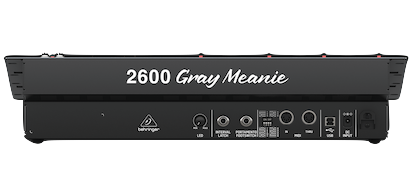 On the rear panel, besides USB and MIDI In and Thru, there are two Pedal connections, one for activating Portamento: I assume a Toggle switch on/off and a Sustain pedal (alternatively) to work like the red Momentary switch. The other pedal connection is the "Interval Latch" input: here the duophony can be used to fix an interval distance when the pedal is activated (toggle or sustain). The dipswitches can be used to set the MIDI channel on which the 2600 is to receive. Finally, the remaining knob can be used to dim the light of the LED sliders. The visual display of the S/H position and the LFO speed will remain unaffected. These optical controls are a welcome new feature as well.
On the rear panel, besides USB and MIDI In and Thru, there are two Pedal connections, one for activating Portamento: I assume a Toggle switch on/off and a Sustain pedal (alternatively) to work like the red Momentary switch. The other pedal connection is the "Interval Latch" input: here the duophony can be used to fix an interval distance when the pedal is activated (toggle or sustain). The dipswitches can be used to set the MIDI channel on which the 2600 is to receive. Finally, the remaining knob can be used to dim the light of the LED sliders. The visual display of the S/H position and the LFO speed will remain unaffected. These optical controls are a welcome new feature as well.
Clone?
The Behringer 2600 is not a clone. It is a new ARP 2600 interpretation, and this "conversion" of the ARP 2600 I consider to be the most successful since the first glance. It has something fresh and lots of really useful improvements. In addition, it is compact and has nothing more 70s-like - including "the behavior".
Sound
Sonically - and I'm talking about "moving", not static sounds - I wouldn't associate the (modern) Behringer 2600 too closely to the historical ARP 2600, because a discrete 15V synth built 50 years ago simply behaves quite differently from a modern synth in SMD design due to distinctly higher component tolerances (electrical) in recent times. However, the modern SMD construction means that the individual instruments can hardly be distinguished from each other - which is generally a good thing, because it eliminates the "lottery factor" as far as the quality of the individual instrument is concerned. However, the sound of the Behringer 2600 Gray Meanie surprised me throughout in a positive manner and surpassed my expectations by far. Only the headphone output makes it sound considerably less attractive, but this is due to the headphone amplifier - I do not care.
Overall, it seems a bit more accurate and refined when playing (due to the smooth sliders) - perhaps more contemporary? I was quite surprised that the ARP Little Brother also sounds more behaved when I connect it - particularly in the ARP Odyssey, where I previously listened to it, it sounded much more brutal - which probably also has to do with the Odyssey's weak VCA. I am pleased of this alteration. In direct comparison, the sounds of the oscillators are amazingly similar, almost identical - and in context, it's hard to determine whether it's Behringer or ARP you're hearing at this point (i.e., the ARP VCO played through the Behringer VCA). The Behringer sometimes has a bit more "peak", the ARP seems somewhat "rounder", but also washier and has a bit more boomy bass. In fact, the Behringer VCO shows some nice details in the sound that the ARP VCO doesn't. I was thinking several times now that this or that would have surely pleased Alan R. Pearlman. As a reminder, the original ARP 2600 Gray Meanie had "finer" parts built into it that were replaced with inferior (cheaper) parts in later series for cost reasons. But these parts also made the 2600 fuzzier, rougher - and Pearlman was not into RocknRoll, more into classical music.
For the sound characteristics of the 2600, the composition of the modules and the type of operability due to the (panel) layout is more decisive than the basic sound, which is therefore not irrelevant, of course. "The package" is right with the Behringer 2600 and it is without a doubt 100% ARP 2600. The modules are (now on one PCB) coordinated with each other and sonically aligned according to the ARP 2600. The reinterpretation is successful - and the Behringer enhancements are a perfect response to the musicians' demands.
Surely, savvy technicians will always find something that might be improved - and, the more complex the modulations, the more pronounced the differences to the ARP 2600 will be. But I think it's the stronger "characteristic" of the aged instruments that makes everything seem to be more special. It's amazing: in contrast to Moog (with its straight harmonics created by an overdrive), ARP used to be considered "HiFi" (= clean signals) - and Moog followers found ARP "cold" or "sterile" because of that. I think, according to these criteria, the old ARP, when compared to the B-2600, adopt the Moog position today.
Sometimes it gives me grief that instruments are not built at "maximum quality", but rather at best economic ratio - though that's a different, more political topic. However, it is also [socially] political that this Gray Meanie for just under € 600.- stands next to synths more than 20x as expensive, without attracting any negative attention - quite the opposite: it confidently celebrates its strengths. I don't think there has been anything like this so far. It's probably the best existing school instrument for electronic music - and it's really well suited for making music with it. This instrument deserves a future - and at least there should be a B-2600 at every school!
Unmet concerns and minor changes
Beforehand, I had a few concerns about the playability and the narrower spacing between the sliders. In fact, it seems to me, on the contrary, it is rather better playable! No feeling of narrowness. The sliders are very comfortable and precisely controllable. I was not expecting this level of quality. I don't just mean the quality, but the overall "standing" of the Gray Meanie. This instrument can easily hold its own!
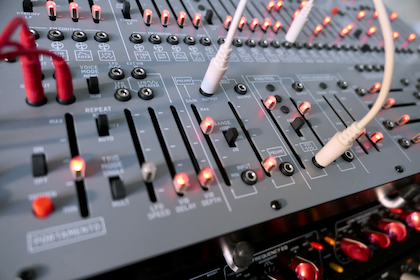 The sharp-edged slider tips are really unpleasant. I had already developed calluses on the index finger and thumb after three days. That is something that musicians do not like at all. That's why I have put "WMD Clear Caps" onto the sliders. 63 sliders means seven bags á 10 pieces for 8 euros (€ 56.-) - also painful - for just a few plastic caps - however, just for one single time.
The sharp-edged slider tips are really unpleasant. I had already developed calluses on the index finger and thumb after three days. That is something that musicians do not like at all. That's why I have put "WMD Clear Caps" onto the sliders. 63 sliders means seven bags á 10 pieces for 8 euros (€ 56.-) - also painful - for just a few plastic caps - however, just for one single time.
About 1/3 needs to be cut off before fitting. I am not a fan of soft plastic and initially it feels a bit "sticky", but improves quickly - however, the unpleasant stinging of the edges becomes a matter of the past immediately.
 What I also didn't like - and which I've already altered - was the piddly headphone volume control. It is very small and slippery, and - because of its size - felt quite awkward and unpleasantly fiddly to adjust. In addition, the position bar is almost invisible. This is where Sifam has brought a significant improvement, for I exchanged the pot cap for a larger "Sifam/Selco Large Skirt" (with D-Shaft). Thus, it is not only possible to adjust with more "grip" and (because of the size) more easily - the position is also immediately identifiable. I have deliberately chosen a "slightly too large" knob. This is much better! As I think, also optically.
What I also didn't like - and which I've already altered - was the piddly headphone volume control. It is very small and slippery, and - because of its size - felt quite awkward and unpleasantly fiddly to adjust. In addition, the position bar is almost invisible. This is where Sifam has brought a significant improvement, for I exchanged the pot cap for a larger "Sifam/Selco Large Skirt" (with D-Shaft). Thus, it is not only possible to adjust with more "grip" and (because of the size) more easily - the position is also immediately identifiable. I have deliberately chosen a "slightly too large" knob. This is much better! As I think, also optically.
As the photos also show, the color gray of the Meanie is much brighter than in the "official" promotional photos. This is also better than I expected. I believe, however, that the coating is pretty sensitive. That of all things a giant ("cheap") company comes up with such a good product (at such a price!) and also very openly communicates, may make oneself think about it.
The "Package ARP 2600"
I like the 2600's "semi-modular" concept, although "semi-modular" actually ought to mean "one-and-a-half-modular": it makes the 2600 much faster to patch, because after disconnecting all the cables, the standard connection is reestablished - and that's especially valuable on stage. The patch sheet "Normals" shows how extensive the basic wiring is for such a beast. If the ARP 2600 were a "fully modular synthesizer", 33 patch cables would be necessary (see picture) to create the state that the "semi-modular" ARP 2600 has when all cables are disconnected.
 Another advantage of the ARP 2600 package, especially for trainees, is that there exists one of the most beautiful manuals in history for it, which is at the same time a profound introduction to electronic music and is focused on this instrument: the "Arp 2600 Owners Manual"! The manual is freely available - Behringer now provides us with the lab for it. Absolutely recommendable. The combination (ARP Manual/Behringer 2600) has what it would take to learn electronic music already at school. After all, nothing about the behavior of pulse or sawtooth waves and their control by Control Voltage has changed. It is the basics. I hope for the prevalence of this assessment and wishing a bright future.
Another advantage of the ARP 2600 package, especially for trainees, is that there exists one of the most beautiful manuals in history for it, which is at the same time a profound introduction to electronic music and is focused on this instrument: the "Arp 2600 Owners Manual"! The manual is freely available - Behringer now provides us with the lab for it. Absolutely recommendable. The combination (ARP Manual/Behringer 2600) has what it would take to learn electronic music already at school. After all, nothing about the behavior of pulse or sawtooth waves and their control by Control Voltage has changed. It is the basics. I hope for the prevalence of this assessment and wishing a bright future.
Suitable for schools and universities, for at home and on stage, for young and old. A teaching, learning and performance instrument, just as A.R. Pearlman had once envisioned. Behringer has expanded this beautiful instrument, brought it into the 21st century and made it accessible and affordable!
With the 2600 Blue Marvin and Gray Meanie, Uli Behringer has launched a big deal! I hope that enough resonance will arise so that these models remain in production. I also like that Behringer did not use - or possibly could not acquire (?) - the name "ARP". "2600", "Blue Marvin", "Gray Meanie" and the unique layout says enough. Let's just say "Behringer 2600". Honour to whom honour is deserved.
Chapeau, Behringer!
Behringer Links
My Gray Meanie(s)
FX in the 2600
With the 2600, you've got a complete instrument. However, a few add-ons in the form of FX pedals are ideal to individualize it a bit in terms of sound. First of all, the most important part: a mono volume pedal. It doesn't change the sound, but it allows for a much more complex playing style. In my case, the volume pedal does not sit behind the stereo main out, but between the VCF and VCA. Here the 2600 is still mono and the advantage is that the sound returns prior to the Reverb (where the 2600 becomes "stereo"). I.e., if the pedal is closed, the reverb does not tear off with it, but decays naturally.
 In the imgage, the Input and Output is marked. The label "FX" (Effects) already indicates the direction in which it proceeds: Here I do not only have a Volume Pedal, but the pedal also passes my (mono-) Pedalboard before it is returned. In the picture, both channels are marked with "from FX", but there is only one channel coming back. I actually always use the left input (VCF), because 1. I provide the VCF attenuation with the pedal and because 2. the right (VCA) channel becomes the "dry" channel. If the Volume Pedal is opened and the FX pedals are set to bypass, the normal circuit of the 2600 is restored.
In the imgage, the Input and Output is marked. The label "FX" (Effects) already indicates the direction in which it proceeds: Here I do not only have a Volume Pedal, but the pedal also passes my (mono-) Pedalboard before it is returned. In the picture, both channels are marked with "from FX", but there is only one channel coming back. I actually always use the left input (VCF), because 1. I provide the VCF attenuation with the pedal and because 2. the right (VCA) channel becomes the "dry" channel. If the Volume Pedal is opened and the FX pedals are set to bypass, the normal circuit of the 2600 is restored.
One pedal that is something important to me, and it was the same on my ARP 2600 40 years ago, is an analog Delay, because I'm not a fan of the tiny Spring Reverbs. They don't sound good and leave "pitched" trails. A Reverb might be important in productions, but, as soon as there is a natural room echo, the reverb destroys or swallows valuable parts of the sound. A short (and gentle) delay is better, in my opinion, to eliminate the "unnatural aridity" that is unique to any electronic sound generation.
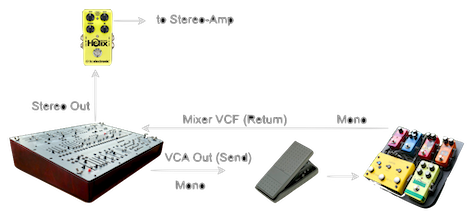 This pretty much explains the FX insert. Which FX pedals are on my pedalboard and which pedals I use to steer them can be found in detail on my pedalboard/FX page.
This pretty much explains the FX insert. Which FX pedals are on my pedalboard and which pedals I use to steer them can be found in detail on my pedalboard/FX page.
- More about ARP Instruments and ARP 2600 on my website: ARP
- More about the Effects I use: Filterbanks and FX
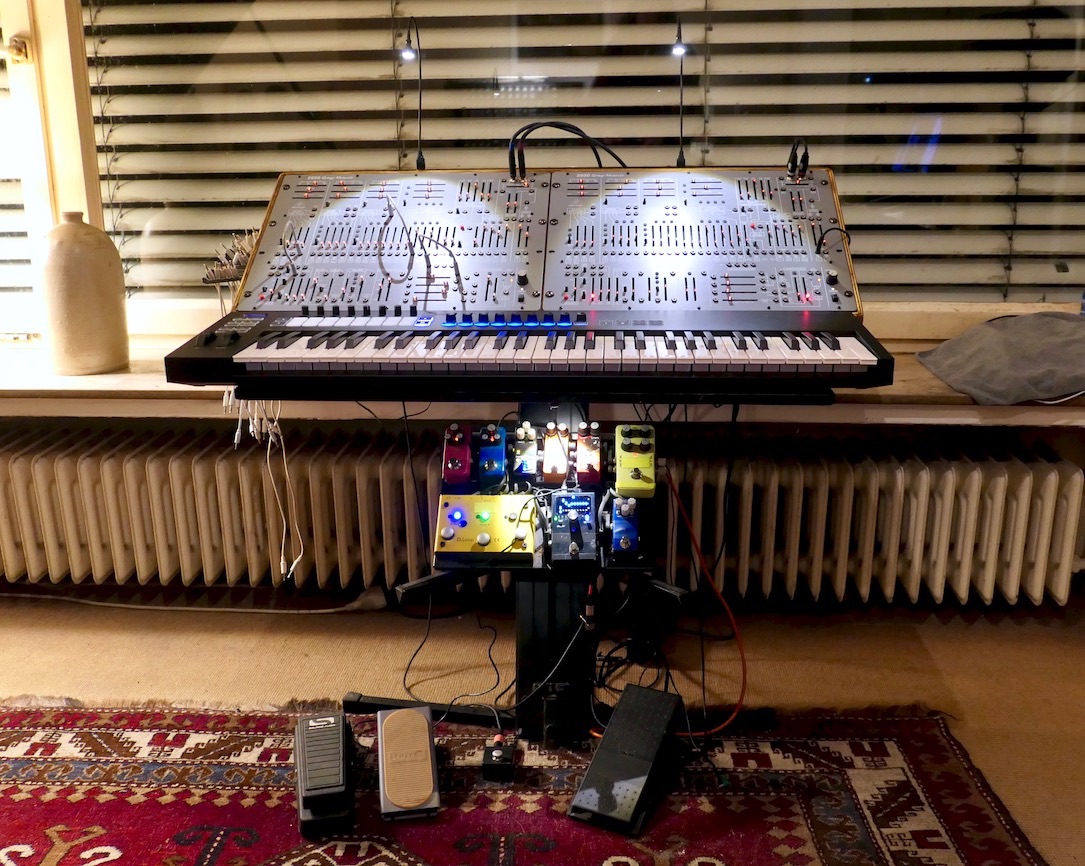
Side Panels
 We've arrived at the customization stage: the Gray Meanie is a screw-in, and it calls for side pieces if not screwed in (to make it look its best). I had made two pairs right away - one for laying down and one for upright standing - since the Gray Meanie is built as lightweight and is so small, it can easily swap places - unlike its neighbor in the picture, which weighs about 10 times as much.
We've arrived at the customization stage: the Gray Meanie is a screw-in, and it calls for side pieces if not screwed in (to make it look its best). I had made two pairs right away - one for laying down and one for upright standing - since the Gray Meanie is built as lightweight and is so small, it can easily swap places - unlike its neighbor in the picture, which weighs about 10 times as much.
Side panels are simple and can be built pretty fast. These are made of 1.5cm thick multiplex, sanded, stained and oiled - and, to ensure that it is not a wobbly affair, I have used threaded screws. This makes attachment and detachment of the side panels a breeze. In the meantime, the wing screws have given way for black lens head screws. A little DIY effort for the instrument binds. With the nice side panels the synth of course also sounds much better immediately.
Vertical or Horizontal?
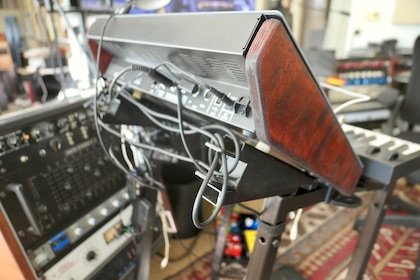 Vertical positioning requires too many muscles, and moving sliders vertically requires the upper arm and shoulder to compensate too much, which causes cramping. That's why I see vertical positioning as being primarily beneficial for teaching, as it gives those present a better view of the panel. With a more horizontal positioning of the sliders, I prefer a 45º or 135° tilt, it allows more wrist based operation. It's a lot more relaxed. I consider it to be better with this instrument (as already with the ARP 2600) to make it a "complete" or central instrument, on which the whole focus is (as is usual with instruments).
Vertical positioning requires too many muscles, and moving sliders vertically requires the upper arm and shoulder to compensate too much, which causes cramping. That's why I see vertical positioning as being primarily beneficial for teaching, as it gives those present a better view of the panel. With a more horizontal positioning of the sliders, I prefer a 45º or 135° tilt, it allows more wrist based operation. It's a lot more relaxed. I consider it to be better with this instrument (as already with the ARP 2600) to make it a "complete" or central instrument, on which the whole focus is (as is usual with instruments).
Cabinet
With the second Gray Meanie, a cabinet was overdue. This instrument deserves its own cabinet ( also individually)! My choice was lightweight poplar wood, which used to be very popular as a material for instrument cases (because of its weight and shock resistance).
 While manufacturing the cabinet, I realized how well the new shape of the 2600 has been chosen - and here, too, Behringer convinces me all the way down the line! If you simply follow the shapes of the B 2600 in the case design, it becomes a beautiful looking instrument - of course, it's purely a matter of taste.
While manufacturing the cabinet, I realized how well the new shape of the 2600 has been chosen - and here, too, Behringer convinces me all the way down the line! If you simply follow the shapes of the B 2600 in the case design, it becomes a beautiful looking instrument - of course, it's purely a matter of taste.
The 2600 has two audio outputs, but is actually mono. Only from the Reverb onwards it becomes two-channel (not stereo), so Synth (mono) goes into Reverb (2x mono) goes into Output (L/R). However, it is a really good option to let the sound move from left to right (or vice versa) or to be able to reposition it. Also, in this configuration, both 2600s don't have to be picked up in stereo (so 4 channels). The second 2600 can be routed e.g. after the VCA via patch cable into the VCF mixer of the first 2600 and be played back through the two channels of the first 2600.
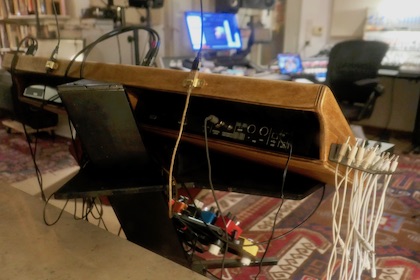 The rear view reveals an important detail of the case, namely the open back panel. All connections are easily accessible. To complete it, I added an entire music stand to it in order to make everything as easy and identical mountable as possible (that's important to me). The power supplies, multi-sockets, pedalboard, etc. create a nifty cable and device mess if you don't organize it well beforehand. I chose a LaunchKey61 Mk3 keyboard, which is almost the same width as the cabinet. I placed the Pedalboard (which is essential for me) underneath the keyboard, the ideal place according to my needs. The FX pedals I "control" are adjusted via pedals, the D.Loop (audio send/return) and the Equalizer are operated via MIDI (presets via the mini drum pads of the keyboard and varying parameters using a Lehle Expression Pedal with USB/MIDI).
The rear view reveals an important detail of the case, namely the open back panel. All connections are easily accessible. To complete it, I added an entire music stand to it in order to make everything as easy and identical mountable as possible (that's important to me). The power supplies, multi-sockets, pedalboard, etc. create a nifty cable and device mess if you don't organize it well beforehand. I chose a LaunchKey61 Mk3 keyboard, which is almost the same width as the cabinet. I placed the Pedalboard (which is essential for me) underneath the keyboard, the ideal place according to my needs. The FX pedals I "control" are adjusted via pedals, the D.Loop (audio send/return) and the Equalizer are operated via MIDI (presets via the mini drum pads of the keyboard and varying parameters using a Lehle Expression Pedal with USB/MIDI).
As a stand I use my 20 years old Ultimate Column Tripod, which I shortened by about 30 cm and modified a little bit.
The construction of the cabinet was conceivably simple.
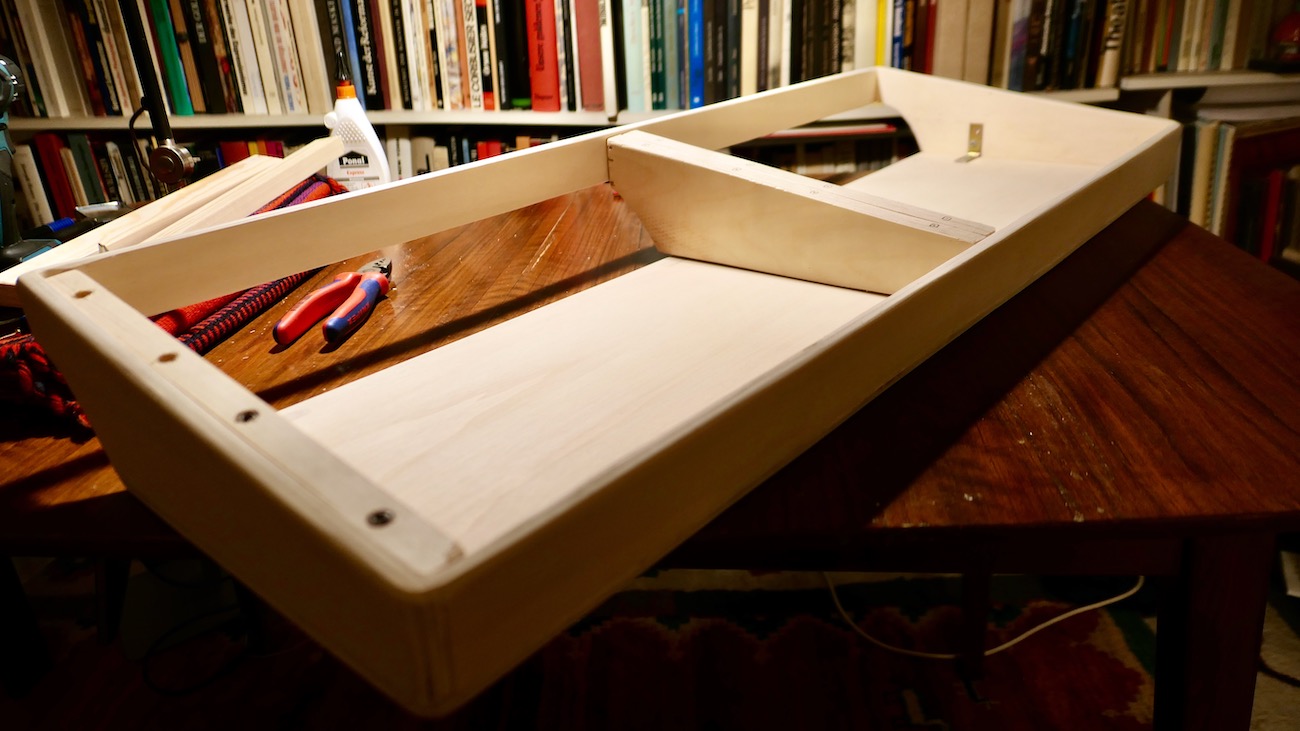
I paid 10 Euros for the (thin) poplar wood (sides and bottom) at the hardware store. The thicker support woods inside were scraps I still had in my workshop... The brass angle, which can be seen in the image, was bolted in only during the gluing (as an aid). After the glue dried, I took it out again.
